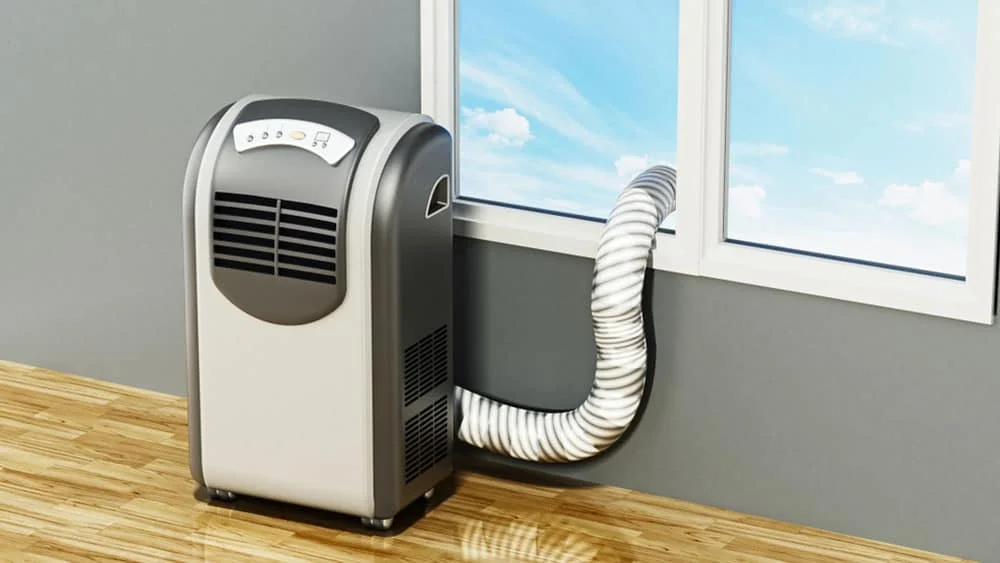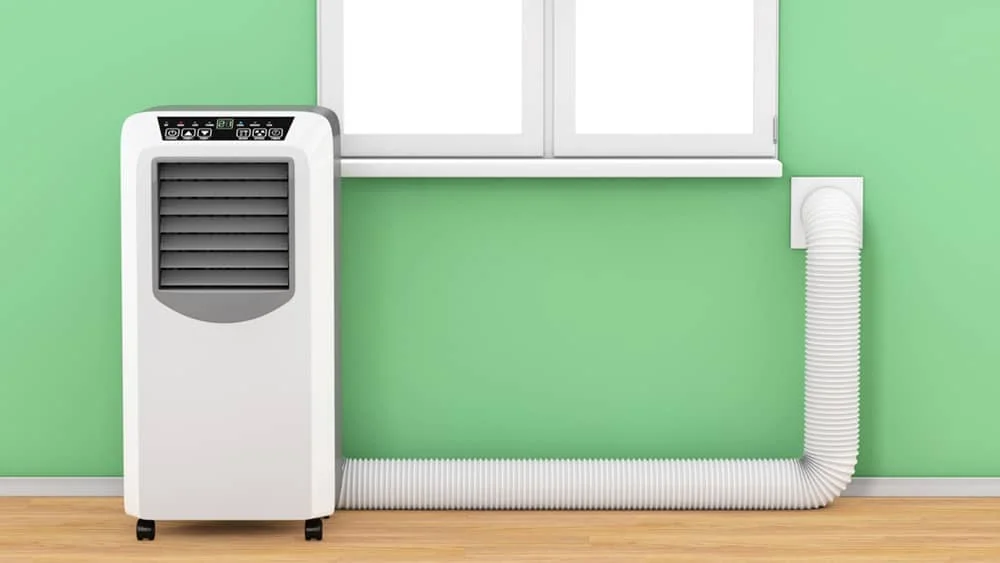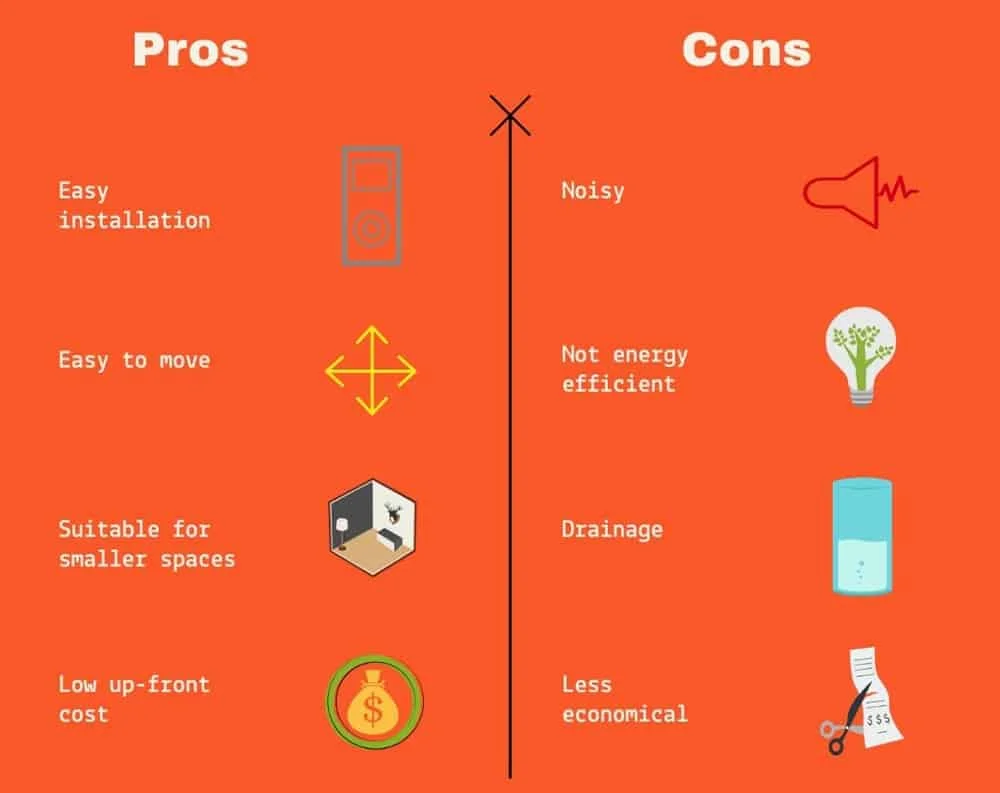
Key Takeaways
- Portable AC units are self-contained units that cool and dehumidify air.
- Single-hose ACs are cost-effective, while dual-hose models offer better efficiency and cooling.
- Portable air conditioners are easy to install and move but are less energy-efficient and can be noisy.
Portable air conditioners are ideal for small areas or targeted cooling. They are especially popular in attics, tiny isolated rooms, and home offices. With their simple installation, mobility, and storage, they provide a convenient and effective cooling solution. Plus, if you opt for a portable heat pump, you may enjoy climate control all year!
This article covers how portable air conditioners work, including insights into single and dual-hose models. It also addresses frequently asked questions, such as whether portable ACs can function without a window and if draining is necessary.
What Are Portable Air Conditioners?
A portable air conditioner, also known as a stand-up air conditioner, is a type of AC that can be moved around very easily. It’s a self-contained unit that can be placed anywhere with access to a window and a power outlet. Equipped with wheels, it can easily move around different areas as needed. With these convenient features, it is considered one of the most versatile air conditioner options.
How Do Portable Air Conditioners Work?
The workings of portable air conditioning units are similar to those of any other AC. A portable air conditioner’s primary job is to pull in room air, chill it to the correct temperature by removing heat, and then circulate the cooled air back into the area.
The basic AC components involved include:
- The evaporator coil and the refrigerant are responsible for cooling the air.
- Condenser coils cool down the hot refrigerant.
- The compressor raises the refrigerant temperature for the condensation process.
- The fan moves the air around as needed.
The fan pulls hot, humid air from the room into the portable air conditioner. The coils inside the unit bring down the air’s temperature and extract water from it through condensation. The cooled air is transferred back indoors.
The refrigerant plays an essential role in the whole process. It is what cools down the room air and is used as a heat exchange medium. It is compressed and then rapidly expanded, cooling it down.
This cooled refrigerant absorbs heat from the indoor air. As the refrigerant is compressed, heat is generated, which needs to be exhausted. Therefore, portable units have an exhaust hose that vents the heat outside the room.
A portable air conditioner can remove moisture collected from the air in three ways:
- Self-evaporation: Portable ACs expel moisture along with warm air through an exhaust vent, a feature commonly found in newer models.
- Gravity drain: The moisture collected is pumped out via a hose.
- Internal bucket: In older models, water collects in a bucket that requires manual draining.
The main difference between portable and other types of air conditioners is that they combine all the components into a single self-contained device. Even the smallest portable ACs operate by consolidating the entire refrigeration cycle within this compact form.
How Do Single-Hose vs. Dual-Hose Portable Air Conditioners Work?
There are two types of portable room air conditioners: single-hose and dual-hose. Let’s examine the difference between the two types and learn how these portable air conditioners work.
How Do Single-Hose Portable ACs Work?

A single-hose portable air conditioner has a single exhaust vent, making it easier to install, cheaper, and thus more popular.
The unit pulls in air from inside the room and cools it. The moisture and heat generated by the cooling process are exhausted outside through the single hose.
Since the unit constantly pulls in the room’s air and does not replace it, negative pressure is created inside the room. As a result, air can seep through door gaps, windows, or other leaks to replace the missing air. This allows hot air from other areas in your house to seep in, causing your air conditioner to work harder to cool the room. This can be prevented by proper insulation and keeping your doors closed to increase the efficiency of your unit.
How Do Dual-Hose Portable ACs Work?
A dual-hose portable air conditioner consists of two separate hoses, which makes it slightly trickier to install and more expensive. However, it is much more energy efficient, and it can bring in fresh air from the outdoors rather than recycling indoor air.
One hose is used to exhaust the heat and moisture generated in the air conditioning process, just like in the single-hose AC. The other hose is used to draw in fresh air from the outside to tackle the negative pressure problem. The outdoor air is released into the room after it is conditioned as per the set temperature.
It requires less work for the dual-hose air conditioner to cool the room, increasing its efficiency. Also, it can bring in fresh air and move out indoor air faster, making the overall process quick with two hoses.
Maintenance of Portable Air Conditioners
To keep your portable AC running in top condition, it is important to look after its maintenance. This will not only help your unit last longer but also keep it running efficiently.
The first step in maintaining a ductless AC is cleaning the air filters. Depending on your usage, it is recommended that you clean the air filters bi-weekly or monthly. If you have pets at home, you might have to clean the vents and filters frequently, as pet hair and dander can cause airflow problems. You can use a smart mini-split thermostat to receive timely notifications when it is time to clean the air filters.
Your best choice to make any mini-split, window,
or portable AC smart. Enhance your comfort and savings.

Related: Pet Comfort & Air Conditioning for Dogs & Cats
The water reservoir should be drained before it starts messing up your room. If your portable aircon isn’t reversible or you don’t plan to use it in winter, it must be stored properly. Clean the device and dry out the water tray to prevent the growth of mold.
Use mild, soapy water and a soft cloth to clean the exterior of your portable AC unit. Avoid putting it in direct sunlight, or otherwise, its color will start to fade over time.
Pros and Cons of Portable Air Conditioners

Now that you know how portable air conditioning units work, let’s focus on their pros and cons to help you decide if they are the best unit for you.
|
Pros of portable air conditioner |
Cons of portable air conditioner |
|
A portable unit is easy to install. You don’t even need to call a professional and can do it all yourself. You need to find an exit for the hose and install it using the toolkit that comes with the unit. |
Since all of the conditioning is done in one unit, portable units are really noisy compared to their alternatives. |
|
Most portable air conditioning units have wheels attached at the bottom. They are also lightweight and can be easily moved from one room to another, depending on your needs. |
Portable air conditioners are generally less energy efficient. The reason is they take more time to condition a room than any other type of AC of the same capacity. |
|
Portable ACs are the best air conditioners for small rooms. If you don’t have a permanent residence and move frequently, they are your best go-to option. |
Water extracted from the air has to be drained. While some portable air conditioners have hoses, others have a water tank. The water tank needs to be drained regularly. |
|
Portable aircon has a low upfront cost and is increasingly becoming more affordable. |
The long-term operational cost of portable room air conditioners does not make them an economical option. |
Related: Are Portable Air Conditioners Worth It? Weighing the Pros & Cons
The Final Word on Portable ACs
In conclusion, portable air conditioners can be a useful and convenient option for cooling specific rooms without the need for permanent installation. They offer flexibility for spaces where traditional AC systems aren’t practical. However, they come with some limitations, such as the need for venting and potential noise levels, which should be considered before making a purchase. Understanding these factors can help you decide if a portable AC is the right solution for your cooling needs.
Frequently Asked Questions
Do Portable Air Conditioners Work Without a Window?
A portable air conditioner comes with an exhaust hose, which you must vent out. However, it is not necessary to vent the exhaust through a window. Depending upon availability and space, you can vent your portable AC through a wall, door, or roof as well.
Do All Portable Air Conditioners Have to Be Vented Out a Window?
You don’t need to rely solely on windows for venting portable air conditioners. As long as the hot air is vented outside the room, the cooling will be effective. Alternatives include venting through doors, walls, or ceilings. You can also choose a unit that doesn't require venting at all, such as an evaporative cooler. The key is to ensure hot air isn't recirculated into the room you're trying to cool.
Do You Have to Put Water in a Portable Air Conditioner?
You don't have to fill in a standard portable AC. However, if you have an evaporative portable room air conditioner, otherwise known as a swamp cooler, you'll have to refill the reservoir with ice and water. Since it does not have an exhaust vent, instead of condensation, it cools the air through evaporation. It works differently from an air conditioner.
What Happens if You Don't Drain Your Portable Air Conditioner?
If you have a self-evaporative or gravity-drained portable AC, then you don't have to worry about draining the water. Both these types take care of it by evaporating or draining it, respectively. But if you have a model that has a water bucket, then you'd have to keep an eye on it. If not emptied when required, the water can spill out of the reservoir, ruining your furniture. If you're not using your portable air conditioning unit daily and let the water sit in the bucket for days, then there is a risk of mold growth.
Do Thermostats Work With Portable Air Conditioners?
Yes! If your portable air conditioner comes with an IR remote, you can pair it with a mini-split thermostat like Cielo Breez Max. Using a mini-stat, you can automate your home's environment. It also helps you save money on electric bills by allowing you to set schedules and monitor usage reports. It is a good add-on accessory for your smart home and is compatible with Amazon Alexa, Google Assistant, Siri Shortcuts, and Samsung SmartThings.
Are Portable Air Conditioners Noisy?
One disadvantage of portable units is that they are very noisy. If you've just bought a portable air conditioner, you may have trouble sleeping beside a loud device. Since they're usually placed on solid floors, the area for vibration is increased, increasing the noise. Try to place a rug under your portable AC to minimize this noise. Additionally, you can check the model's decibel rating before making your purchase. Go for a model that has a lower decibel rating.
Are Portable Air Conditioners Energy-Efficient?
Generally speaking, portable air conditioning units are not an energy-efficient solution. As mentioned above, portable ACs constantly generate heat while conditioning the room, making the cooling process longer. This results in increased energy usage and also significantly impacts your bills.
However, if you only have to condition a small/single room, a portable air conditioner would be a better option than a central heating system.
What Should I Look for When Buying a Portable Air Conditioner?
Before buying a portable room air conditioner, set aside a budget. Then, filter out the choices that fall within your budget. After that, check what AC size is right for your room. Depending upon the space in your room, give preference to dual-hose units. Lastly, choose a model that also offers a heating option for year-round use.









9 Comments. Leave new
Very useful article .
I have a Danby single hose for years but lately it’s no longer as efficient as it used to. It’s been on for hours and the room is still not as cool as it should. My question is – do these portable ACs need their freon/refrigerant replaced or topped up? Is that even possible?
Normal AC transfer room heat to outer space, how portable AC Transfer heated gas heat ?
Does the unit get low on freon and need recharging? I think ours could be icing up inside
Yes, refrigerant leakage can occur in portable units and causes issues like low airflow, long cooling cycles, and frozen refrigerant lines.
To keep your portable AC running in top condition, it is important to look after its maintenance. This will not only help your unit last longer but also keep it running efficiently. I got the air conditioner many years ago and it is working like new now.
Do most dual hose AC’s have a recirculate setting?
Hi Kelly, try using your dual hose portable AC on a fan mode for recirculation. In this case, your unit will act as a fan and recirculate the air already present in the room without taking in fresh air from the outside.
I use one for my garage in Florida. It works great and consumes less energy than a ducted unit.